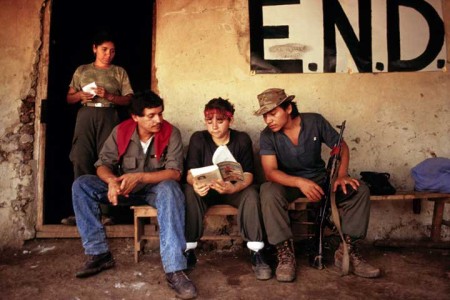There was rejoicing in the streets when the agreement reached between the Salvadoran government and the guerrilla leaders of the FMLN (Farabundo Marti National Liberation Front) ended 12 years of civil war. But the process of transition to democratic civil society has faced persistent problems.

Guerrilla combatants from the FMLN prepare to demobilize in zones under United Nations protection, Cabañas, El Salvador, 1992. Copyright © Donna De Cesare
While the peace agreement overseen by the UN opened political participation to former insurgents, reduced the size of the peacetime armed forces and mandated Truth Commission investigations into war-time human rights abuses, it did not directly address some pivotal issues of social justice. A system of impunity and an inefficient and bureaucratic land titling system continued to favor the wealthy.
The Salvadoran consumer economy relied heavily on “remittance” dollars sent to families by their relatives in the United States. Those who did not have family in the US, especially peasants living in rural areas, faced post-war life in impoverished conditions like those that initially lead to the war.
Efforts to undo the blanket amnesty given to war criminals and to reform the Salvadoran justice system’s accountability lagged in part because Salvadoran civil society played a limited role in reform efforts.
Links:
- El Salvador: War, Peace, and Human Rights, 1980-94, (National Security Achives).
- Timeline of Salvadoran history from PBS.